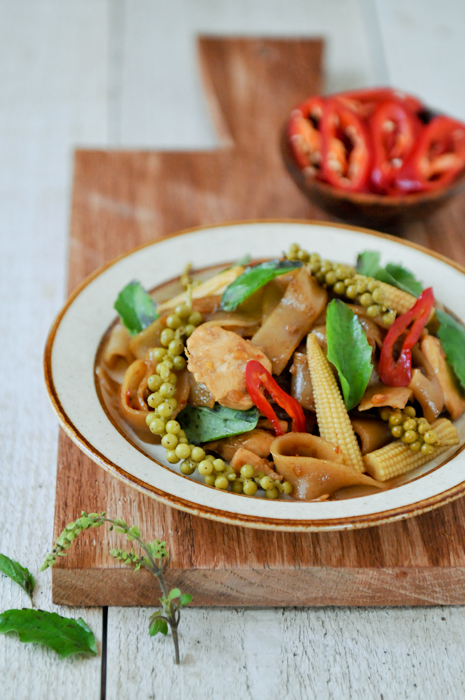 Last weekend, the boyfriend and I decided to check out some Thai grocery stores that we'd heard about across town. We drove from one store to the next, excitedly finding all kinds of things that we can't normally find closer to home, such as Thai holy basil (bai krapow/ใบกะเพรา). Upon spotting this revered herb, I knew I would be spending the rest of the weekend perfecting recipes for drunken noodles (pad kee mao/ผัดขี้เมา) and stir fried chicken with holy basil (gai pad krapow/ผัดกระเพรา), two dishes whose star ingredient is holy basil.
Last weekend, the boyfriend and I decided to check out some Thai grocery stores that we'd heard about across town. We drove from one store to the next, excitedly finding all kinds of things that we can't normally find closer to home, such as Thai holy basil (bai krapow/ใบกะเพรา). Upon spotting this revered herb, I knew I would be spending the rest of the weekend perfecting recipes for drunken noodles (pad kee mao/ผัดขี้เมา) and stir fried chicken with holy basil (gai pad krapow/ผัดกระเพรา), two dishes whose star ingredient is holy basil.
Holy basil is quite different from the regular Thai basil that has sweet leaves and purple stems. Holy basil has green, fuzzy stems with soft, jagged-edged leaves. It's quite fragile and will wilt quicker than Thai basil if its stems aren't in water. The taste of holy basil is also very unique - somewhere between basil and mint with a really strong pepper flavor.
It's this peppery flavor that makes holy basil work so well in drunken noodles. These noodles are somewhat similar to pad see ew except that they're much much spicier - so spicy, in fact, some say, it's the perfect dish to eat when you're drunk (this is just one of multiple theories on the origin of this dish's name - who knows which one is correct). The spice of drunken noodles comes from Thai chili peppers, red jalapeno peppers, and young green peppercorns. The peppery flavor of the holy basil works well to mirror and enhance these flavors.
 The first time I made drunken noodles, I used three Thai chili peppers and I would definitely classify that dish as "Thai hot". I managed to finish my plate, but it wasn't without a few drops of sweat. How did the boyfriend fare, you ask? Well, I'd rather not embarrass him on this blog... (just kidding, he's Thai, after all, of course he did fine!)
The first time I made drunken noodles, I used three Thai chili peppers and I would definitely classify that dish as "Thai hot". I managed to finish my plate, but it wasn't without a few drops of sweat. How did the boyfriend fare, you ask? Well, I'd rather not embarrass him on this blog... (just kidding, he's Thai, after all, of course he did fine!)
My second attempt with two chili peppers was much more tolerable and what I'd recommend starting with if you're unsure of your spice tolerance. And after figuring out your prefered level of spiciness, it's really quite simple to cook. If you can make pad see ew, you'll be a pro at making these drunken noodles!
Recipe
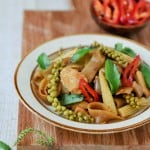
Ingredients
- 8 ounces fresh wide rice noodles
- 4-8 cloves garlic
- 2-3 Thai chili peppers
- 1 cup Thai holy basil leaves
- 2 tablespoons young green peppercorns
- 1 cup chicken
- ½ cup baby corn
- 1 red jalapeno pepper
- 2 tablespoons sweet dark soy sauce
- 2 tablespoons oyster sauce
- 2 teaspoons thin soy sauce
- 2 teaspoons sugar
- 2 teaspoons vinegar
Instructions
- Prepare your vegetables. Chop the garlic and chilis very finely. Cut the baby corn into bite-sized pieces. Slice the jalapeno thinly on the diagonal. Remove the holy basil leaves from the stems.
- Prepare your sauce by mixing the sweet dark soy sauce, oyster sauce, thin soy sauce, sugar, and vinegar together.
- Prepare your chicken by slicing into thin pieces and blanching until cooked. Loosen your rice noodles by blanching for just a second or two and separate them gently with your fingers, if needed.
- Heat a few teaspoons of oil over high heat. Add the chilis and garlic and stirfry until golden brown.
- Then add the rice noodles. Stir fry together for a minute and then add the sauce mixture you prepared earlier and stir fry a little longer.
- Add the chicken, baby corn, jalapeno peppers, and peppercorns and cook for a minute or two longer.
- Then add the holy basil and cook just until wilted. Take off heat and serve immediately!
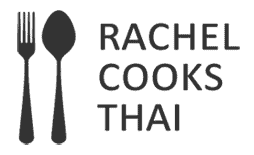


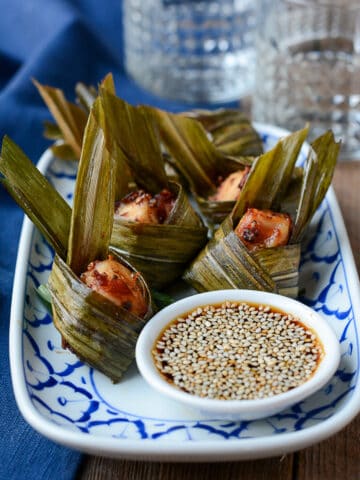
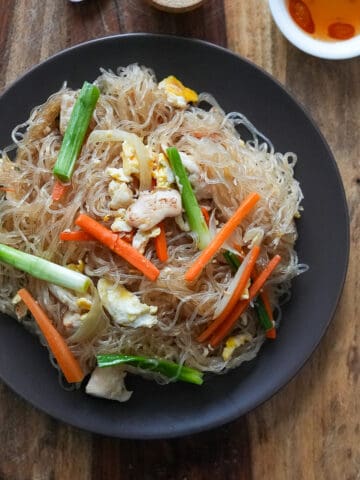
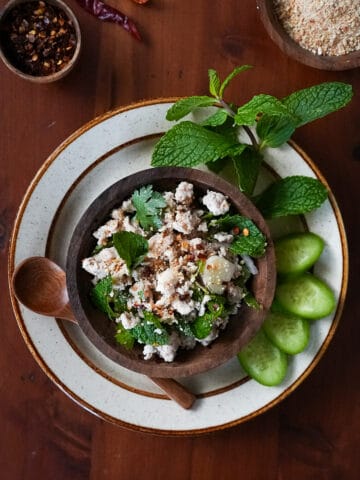

Shey
Hi Rachel, I've just returned from shopping for - amongst other things - baby corn. There was a tin of the stuff and one brand of packaged fresh produce. It was per kilo the price of a good steak (16 Euro or dollar). Err, well, I refrained, remembering it doesn't even taste of much anyway. Any suggestions for an alternative.
Also: metric measurements are highly welcome, unless of course you should want to limit your audience to your neck of the woods. Thanks!
Aparna
I know this is much later than your post, but I stumbled upon your blog post as I was looking for the difference between pad see ew and pad kee mao. I had no idea about holy basil being different, but now that i see the picture on your blog, just a bit of trivia - In India, we call this Tulsi, and it is considered a holy plant by a lot of Hindus. Its leaves are used in worship and it is not to be disrespected. Traditionally, Indian women would plan this herb in a pot the moment they get to a new home. To me, I know this as the plant to look for whenever anyone has a cold -Tusi leaves with warm honey helps relieve colds. I knew Tulsi and basil are somewhat related, but thank you for bringing them together :).
Dylan
I couldn't find holy basil, so I used Thai basil and the recipe still turned out amazing. Thanks!
Rachel
Thanks, Dylan! Glad to hear it.
Trevor
I have been trying to find a recipe for Pad Kee Mao for a while, but it never turned out nearly as good as in Thai restaurants. This is definitely the best it has ever turned out for me! I found the sauce slightly thicker and sweeter than my favorite restaurant, but I think I liked this even better.
Rachel
Awesome! Glad to hear, Trevor.
Bill B.
Only one ingredient in your list told me that this was an authentic Thai recipe. And no, it wasn't the difference between Thai Basil and Holy Basil (though highly helpful and rarely found on other sites). No, not even the use of green peppercorns. Both are great recommendations. What makes this recipe more authentic than most others I've found on the internet is the use of vinegar! It's one of the unique differences that makes this dish different from Pad See Ew. It's what gives this dish its' distinctive tang or bite. I am half-Thai and spent my childhood growing up in Thailand eating this wonderful dish. Thank you for the recipe. I was told by my Thai mother that this dish was named because it is a combination of a LOT of ingredients (not unlike rummaging through your fridge at 2:00 AM looking for something to eat and throwing a little of everything into the mix). You've inspired me to make this dish for dinner tonight.
Christine
Thanks for making my "OK" Drunken Noodles AMAZING!! My guests were raving!! Love your blog. Can't wait to tackle Pad Thai next-- if I dare!!
Rachel
So glad you liked it, Christine!
Rachel
Hi Ashby! I'm not so sure about mature peppercorns... I'd probably skip them or substitute bell pepper strips instead.
Eatingpuertorico.wordpress.com
making this tonight! looks great! i couldnt find young green peppercorns, though--only mature ones...should i still use them? thanks!